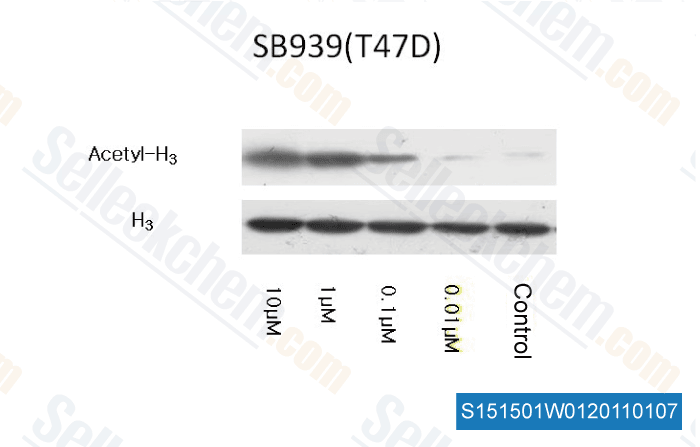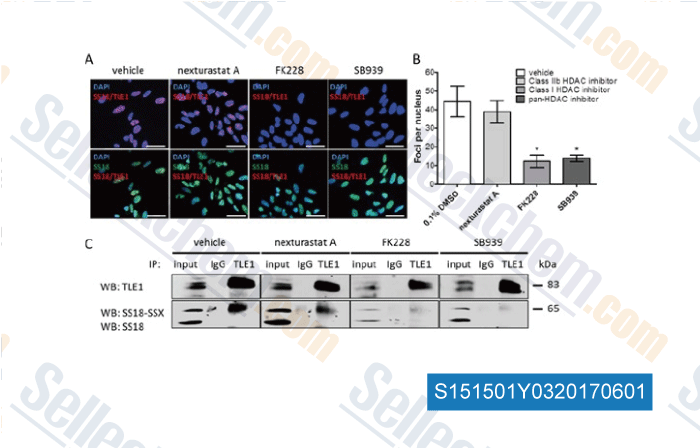|
Toll Free: (877) 796-6397 -- USA and Canada only -- |
Fax: +1-832-582-8590 Orders: +1-832-582-8158 |
Tech Support: +1-832-582-8158 Ext:3 Please provide your Order Number in the email. |
Technical Data
| Formula | C20H30N4O2 |
|||
| Molecular Weight | 358.48 | CAS No. | 929016-96-6 | |
| Solubility (25°C)* | In vitro | DMSO | 72 mg/mL (200.84 mM) | |
| Ethanol | 34 mg/mL (94.84 mM) | |||
| Water | Insoluble | |||
|
* <1 mg/ml means slightly soluble or insoluble. * Please note that Selleck tests the solubility of all compounds in-house, and the actual solubility may differ slightly from published values. This is normal and is due to slight batch-to-batch variations. * Room temperature shipping (Stability testing shows this product can be shipped without any cooling measures.) |
||||
Preparing Stock Solutions
Biological Activity
| Description | Pracinostat (SB939) is a potent pan-HDAC inhibitor with IC50 of 40-140 nM with exception for HDAC6. It has no activity against the class III isoenzyme SIRT I. Pracinostat (SB939) induces apoptosis in tumor cells. Phase 2. | |||||||||||
|---|---|---|---|---|---|---|---|---|---|---|---|---|
| Targets |
|
|||||||||||
| In vitro | SB939 has a 100-fold greater selectivity for HDACs than for Zn-binding non-HDAC enzymes, receptors, and ion channels. SB939 is a potent inhibitor of HDAC class I isoenzymes, HDAC1, HDAC2, HDAC3 and HDAC8 with the IC50 values ranging from 43 nM to 140 nM. SB939 inhibits HDAC class II isoenzymes , HDAC4, HDAC5, HDAC7, HDAC9 and HDAC10 significantly with the IC50 values ranging from 40 nM to 137 nM, with the exception of HDAC6 which shows IC50 of 1008 nM. It markedly inhibits HDAC11 of the HDAC class IV enzymes with IC50 of 93 nM, but shows no inhibitory activity against SIRT 1 of the class III HDACs. SB939 shows significant antiproliferative activity against a wide variety of tumor cell lines, especially Leukemia cells and cutaneous T-cell Lymphoma cells with IC50 values ranging from 50 nM (H9 cells) to 170 nM (HEL92.1.7 cells). [1] | |||||||||||
| In vivo | Administration of SB939 (25 mg/kg to 100 mg/kg) displays a dose-dependent antitumor efficacy in a xenograft mice model of human colorectal cancer (HCT-116). This is approximately twice as efficacious as SAHA: SB939 causing a tumor growth inhibition of 94% versus 48% by SAHA with both at the maximum tolerated dose. Oral administration of SB939 at a dose of 50 mg/kg or 75 mg/kg in the APCmin genetic mice model of early-stage colon cancer markedly reduces the number of tumors , decreases cumulative hemocult scores and increases hematocrit values more effectively than 5-fluorouracil. [1] | |||||||||||
| Features | A new histone deacetylase inhibitor based on hydroxamic acid, with improved physicochemical, pharmaceutical, and pharmacokinetic properties. |
Protocol (from reference)
| Kinase Assay:[1] |
|
|---|---|
| Cell Assay:[1] |
|
| Animal Study:[1] |
|
Customer Product Validation

-
Data from [Data independently produced by Antimicrob Agents Chemother, 2012, 56(7), 3849-56]

-
Data independently produced by , , Dr. Zhang of Tianjin Medical University

-
Data from [Data independently produced by , , Oncotarget, 2016, 7(23):34384-94]

-
Data from [Data independently produced by , , PLoS One, 2017, 12(3):e0174107]
Selleck's Pracinostat (SB939) has been cited by 24 publications
| Epigenetic and molecular coordination between HDAC2 and SMAD3-SKI regulates essential brain tumour stem cell characteristics [ Nat Commun, 2023, 14(1):5051] | PubMed: 37598220 |
| Epigenetic and molecular coordination between HDAC2 and SMAD3-SKI regulates essential brain tumour stem cell characteristics [ Nat Commun, 2023, 14(1):5051] | PubMed: 37598220 |
| Nuclear oligo hashing improves differential analysis of single-cell RNA-seq [ Nat Commun, 2022, 13(1):2666] | PubMed: 35562344 |
| The novel histone deacetylase inhibitor pracinostat suppresses the malignant phenotype in human glioma [ Mol Biol Rep, 2022, 10.1007/s11033-022-07559-y] | PubMed: 35622308 |
| CREBBP cooperates with the cell cycle machinery to attenuate chidamide sensitivity in relapsed/refractory diffuse large B-cell lymphoma [ Cancer Lett, 2021, 521:268-280] | PubMed: 34481935 |
| Exposure of Microglia to Interleukin-4 Represses NF-κB-Dependent Transcription of Toll-Like Receptor-Induced Cytokines [ Front Immunol, 2021, 12:771453] | PubMed: 34880868 |
| Identification of Required Host Factors for SARS-CoV-2 Infection in Human Cells [ Cell, 2020, S0092-8674(20)31394-5] | PubMed: 33147445 |
| Pracinostat (SB939), a histone deacetylase inhibitor, suppresses breast cancer metastasis and growth by inactivating the IL-6/STAT3 signalling pathways. [ Life Sci, 2020, 248:117469] | PubMed: 32109485 |
| Targeting NAD+ Biosynthesis Overcomes Panobinostat and Bortezomib-Induced Malignant Glioma Resistance [ Mol Cancer Res, 2020, 18(7):1004-1017] | PubMed: 32238439 |
| Targeting NAD+ biosynthesis overcomes panobinostat and bortezomib-induced malignant glioma resistance. [ Mol Cancer Res, 2020, 10.1158/1541-7786.MCR-19-0669] | PubMed: 32238439 |
RETURN POLICY
Selleck Chemical’s Unconditional Return Policy ensures a smooth online shopping experience for our customers. If you are in any way unsatisfied with your purchase, you may return any item(s) within 7 days of receiving it. In the event of product quality issues, either protocol related or product related problems, you may return any item(s) within 365 days from the original purchase date. Please follow the instructions below when returning products.
SHIPPING AND STORAGE
Selleck products are transported at room temperature. If you receive the product at room temperature, please rest assured, the Selleck Quality Inspection Department has conducted experiments to verify that the normal temperature placement of one month will not affect the biological activity of powder products. After collecting, please store the product according to the requirements described in the datasheet. Most Selleck products are stable under the recommended conditions.
NOT FOR HUMAN, VETERINARY DIAGNOSTIC OR THERAPEUTIC USE.
